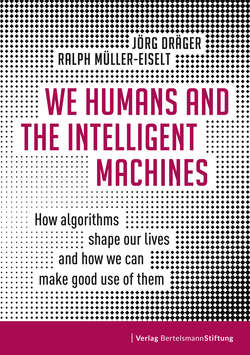Читать книгу We Humans and the Intelligent Machines - Jörg Dräger - Страница 15
На сайте Литреса книга снята с продажи.
Information overload: Drowning in the flood of data
ОглавлениеThe radiology department at the University Hospital in the German town of Essen is nothing but a huge data-processing machine. It is big enough that visitors can take an extended stroll through the premises. The rooms on the right and left of the long corridor are, even now, on a sunny afternoon, dim and dark. With the blinds closed, radiologists sit in front of large monitors and process data. They are the central processing units of radiology. The specialists click through information: patient files, x-rays, scans, MRIs. In one room, images of the brain of a stroke patient flicker across the monitors while, next door, cross-sectional images of a lung with metastases are examined.
The radiologists at the hospital look at a good 1,000 cases per day. The amount of information they have to process has multiplied in recent years – and not only in Essen. Researchers at Mayo Clinic in the United States have evaluated 12 years’ worth of the organization’s data and duty rosters. During that time, not only did the number of annual examinations almost double, the volume of recorded images increased rapidly. In 1999, one doctor examined 110 images per patient, compared to 640 in 2010. Mayo Clinic hired additional staff, but not as fast as the data to be analyzed grew. The result is a challenge: While in 1999 a doctor viewed and evaluated three images per minute, in 2010 she had to look at more than 16 images per minute – one every three to four seconds – in order to cope with the information flooding in over the course of an eight-hour work day.2
For patients, the extra data can be life-saving. When Michael Forsting, Director of Radiology at the University Hospital in Essen, looked at cross-sectional images of the brain as a young doctor in the 1980s, each one showed a section 10 to 12 millimeters thick. There was a significant probability of overlooking a metastasis seven millimeters in diameter. Today, each image depicts one millimeter of the brain. The seven-millimeter metastasis, which used to remain undetected between images, is now visible in seven pictures. New technical processes are capturing reality in much greater detail. Hospitals, however, no longer have the human resources to take full advantage of the quality of their findings. As Forsting says: “We have 10 times more pictures. A CT of the brain used to consist of 24 images, now it’s 240. And someone has to take a look at them.”3
The challenge in radiology is exemplary of those present in other areas, such as identifying the fastest route in urban traffic or coping with the mass of scientific literature on any given subject. Technical advances are improving the amount and quality of data, and technology must help determine the relevant parts of this flood of information. Doctors can now create images of the body down to the smallest cell using computer tomography. Instead of palpating for tumors, radiologists use CTs or MRTs to search for abnormal cellular changes. These days, more data are available than a physician can effectively process using traditional methods. Even the best radiologists would not be able to evaluate 160 images per minute, instead of today’s 16. Any attempt to achieve better results in this way is doomed to fail since the quality of a physician’s judgment declines as he or she grows tired.
An increase in personnel would not be a solution. Apart from the question of funding such a move in today’s already expensive healthcare system, the race against the constantly growing amount of data cannot be won with new hires. Algorithmic tools are needed instead, and doctors should be open to that. After all, monotonously processing x-rays in a darkened room is not what humans do best, neither is it the core competence of highly trained radiologists – and it is certainly not the reason why someone chooses this profession.
